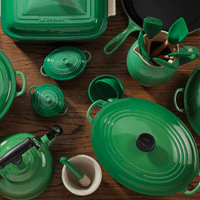Pots and pans are a staple in any kitchen. From the tiniest of tabletop skillets to gargantuan steam kettles, choosing the right one is an exercise in economics and research.
It’s easy to choose the lowest-priced pan in a pinch, but equipment with poor quality materials and construction will likely need to be replaced in a year or two. On the other hand, a well-considered investment in mid- to top-of-the-line offerings can keep your pots in rotation for 10 years or more.
“Unfortunately cookware can be an afterthought with chefs and owners,” says Scott Davidson, chef at Davidson Chef Consulting in Toronto. “They don’t have a problem spending money on a top-of-the-line charbroiler, but when it comes to a pan, they start counting their pennies. Ultimately that affects cooking, because you won’t get the consistency. Like everything else, you should pay for quality ingredients.”
While cookware may not have the technical complexities of a combi-oven, the science behind pots and pans can differ in terms of the type of metal content to the bonding processes and construction. Sometimes aesthetics come into play. At West Restaurant in Vancouver, for example, a lineup of copper-clad pots and pans in the open kitchen add to the ambiance. “When you have a show kitchen, it’s nice to display a lot of copper,” says Quang Dang, executive chef at the high-end restaurant. His collection from France features stainless steel and copper bonded into one piece of metal, so there’s minimal wear and tear and need for replacement, he says.
But, given the cost and special care required, it’s not all about copper at West. The majority of the cookware is stainless steel from Le Creuset, Dang explains. “It can take a beating. If you have aluminum, it can leave a tinny taste in food, and it’s just not as durable.”
Aluminum pots and pans have proponents and detractors, but they are a popular mainstream choice for cookware, because of fast heating and cooling properties. So, it’s commonly placed between surfaces, such as stainless steel, to improve performance without affecting the taste of food, Davidson explains.
Most aluminum pro-ducts feature a non-stick coating, which causes considerable debate among chefs. “Non-stick pots are sensitive, and once you get a scratch, they’re pretty much garbage since you don’t want to get Teflon flakes in the food,” Dang says. “I have, however, seen non-Teflon green pans that won’t leach chemicals into your food.”
“The truth is, the biggest enemy when it comes to non-stick coatings is heat,” notes chef Richard Rupp, a corporate product training manager for Vollrath, based in Sheboygan, Wis. “Overheating degrades the components. But if you get a pan with a good quality, durable coating and use it properly, it can last.”
Davidson says enamelled cast iron can serve as an alternative to non-stick, because it eliminates concerns about PFOA (perfluorooctanoic acid) content associated with other coatings and provides even heat distribution.
At the new Oliver & Bonacini restaurant in the Arcadian Court in Toronto, Jamie Meireles, corporate events chef, says the renovation brought with it some old-school cookware, including massive steam kettles from the 1940s and ’50s. But when it comes to new additions, he looks to All-Clad and Le Creuset as his mainstays. “They’re very durable, good quality and cook evenly. You take a hit at the beginning with the price, but compared to cheaper ones, they last forever.” Meireles estimates he would “probably pay 30 to 40 per cent more [for the high-end products] than for a medium-grade product.”
Meanwhile, presentation cookware for buffets and tables is also a growing trend, Davidson confirms. “There are some very cool new cast-iron skillets from companies, such as Tennessee-based, Lodge Cast Iron, that you can bring to the table. The smells get people hungry and make service a bit more creative,” he says, referring to the cookware manufacturer.
For chef Johnathan Canning, an instructor at the SAIT’s School of Hospitality and Tourism in Calgary, the rules for selecting pots and pans are simple: go for durability and quality. He’s particularly fond of Paderno’s professional line. “It’s all stainless steel with heavy bottoms, which is important for conducting heat and easy to clean. And it’s Canadian, which appeals to me,” he says.
Davidson cites a number of honourable mentions in the cookwares category that span various price points. “If you’re going high-end, and you have the budget, one of the most popular with chefs is Vollrath and All-Clad. Lagostina and Paderno are also good mid-range choices.” Retail prices are difficult to pin down, but according to Vollrath, a natural-finish 10” stainless-steel frypan costs about $32 for a low-end product, $80 for a mid-range product and $155 for a high-end product.
Pots and pans can be a big investment, so once you find the right fit, you stick with it. “Basically you find what you like and run with it. When you have something that doesn’t give you problems, it’s tough to consider anything else,” says Canning.
Keep Reading
Wireless Wonders: Driving Sales with Innovative Technology
Feasting on Favourites: 50 Favourite Things from Canada’s Top Chefs





















